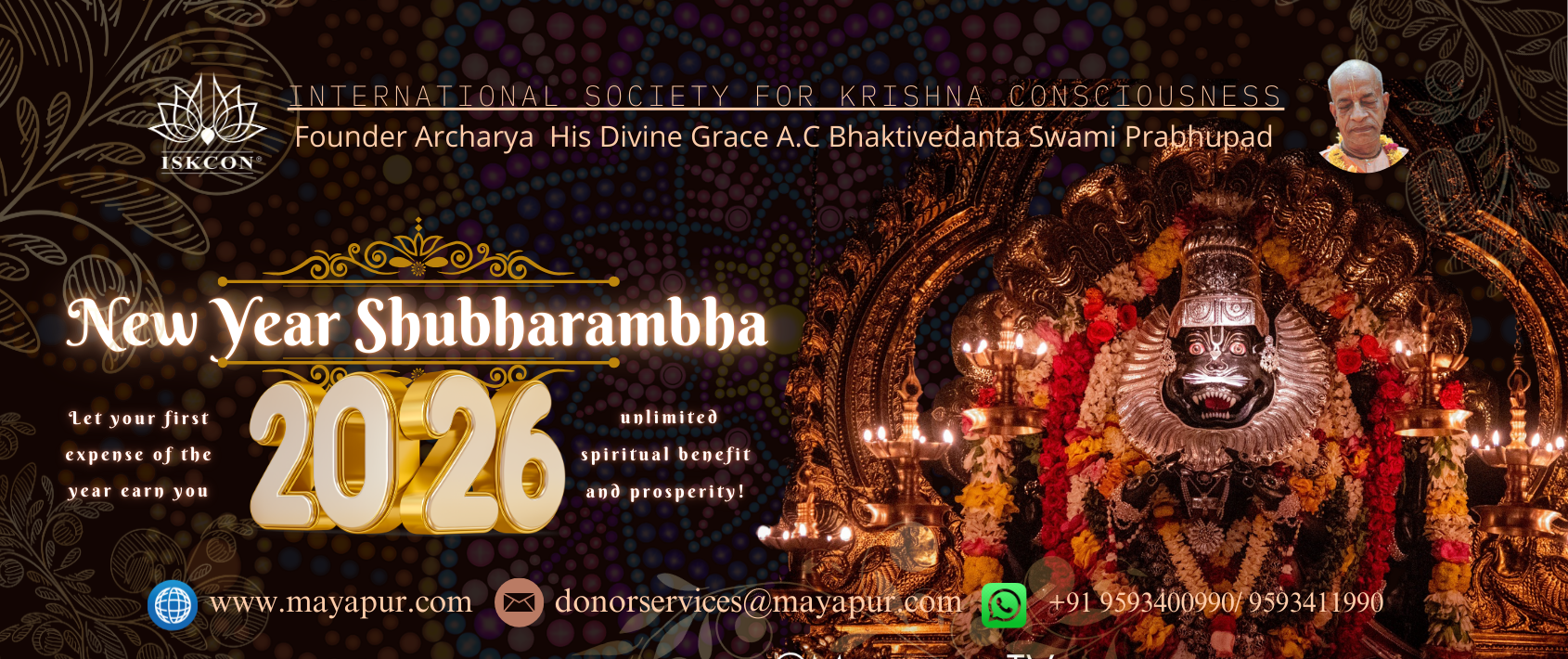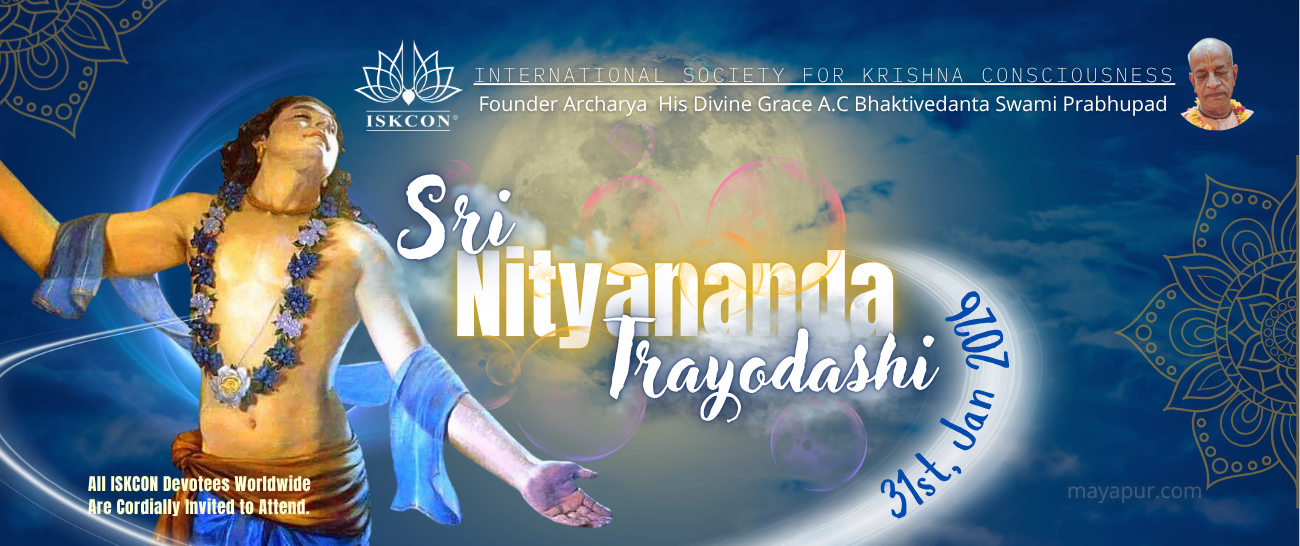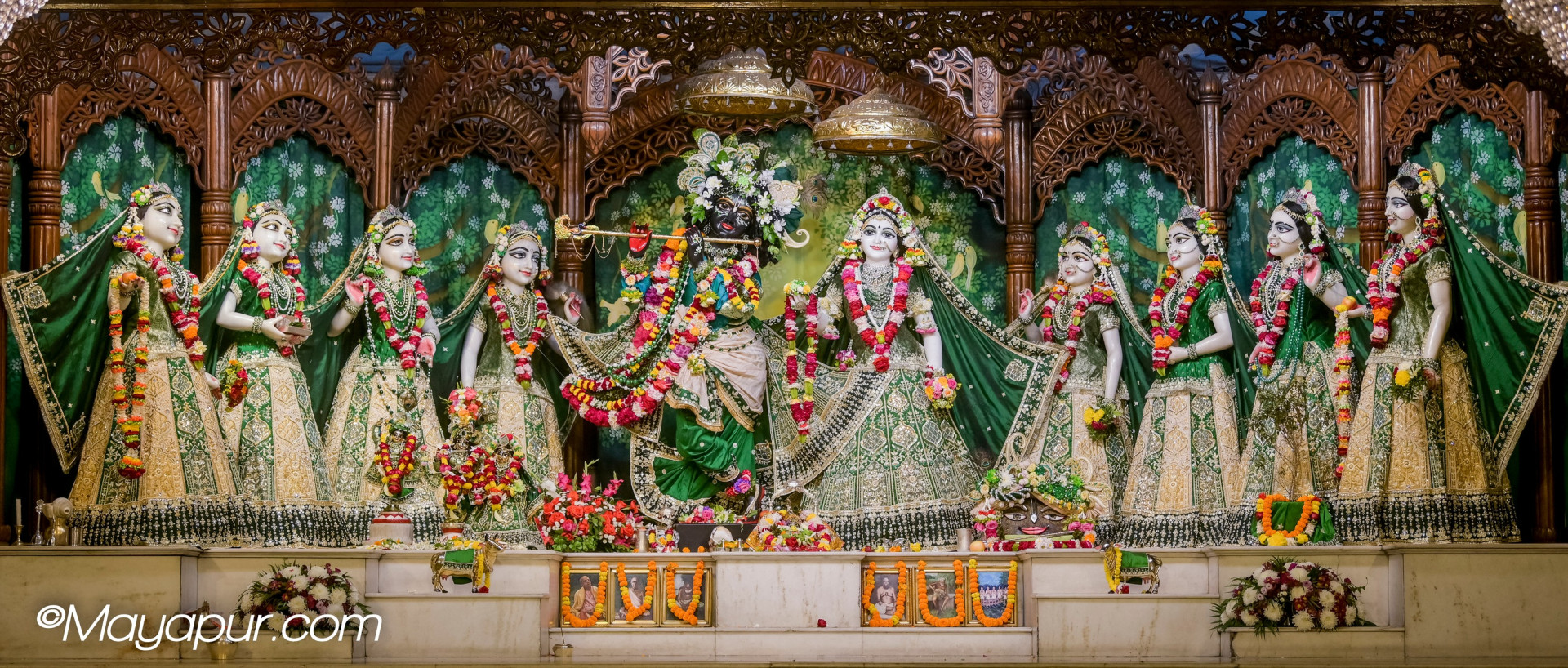

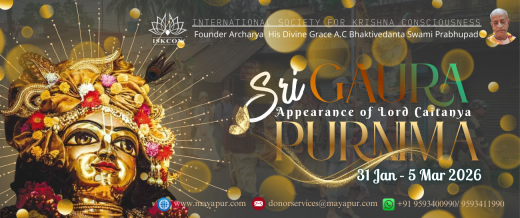
Over 500 years ago, in the sacred land of Navadvīpa, the Supreme Personality of Godhead, Śrī Krishna, appeared as Śrī Caitanya Mahāprabhu. Taking on the golden hue of Śrīmatī Rādhārāṇī, He descended to distribute the yuga-dharma—the congregational chanting of the holy names. Through His boundless compassion, He transformed hearts through kīrtana, love, and devotion, opening the doors of bhakti to the entire world.
Śrīla Prabhupāda repeatedly expressed his heartfelt desire:
that all devotees gather every year in Śrī Māyāpur-dhāma—especially during the time of Gaura Pūrṇimā—to receive mercy, recharge spiritually, and deepen their connection with the mission of Lord Caitanya.
Following in his footsteps, we extend a warm and loving invitation to you and your family to join us for:
GAURA PŪRṆIMĀ FESTIVAL 2026
31 January – 5 March · Śrī Māyāpur Candrodaya Mandir
| Date | Event |
|---|---|
| 31st January | Śrī Nityānanda Trayodaśī |
| 04th – 14th February | GBC Plenary, SGGS |
| 06th February | 152nd Appearance Day of Śrīla Bhaktisiddhānta Sarasvatī Ṭhākura Prabhupāda |
| 08th February | Devotees Arrival |
| 09th February | Śrīla Prabhupāda Connect Day (English/Russian) |
| 10th – 12th February | Śravaṇa Utsav |
| 11th February | Yajña Shala Inauguration at TOVP |
| 13th February | Ekādaśī, Festival Inauguration (Garuda–Dhvajā) Flag Hoisting, Deity Report (Morning), GBC Istāgoṣṭhī & Kīrtana Melā Adhivāsa |
| 14th – 18th February | Kīrtana Melā |
| 14th February | SGGS & Māyāpur Saṅkīrtana Book Distribution Awards |
| 16th February | Śrī Śiva–rātri at ISKCON Rājāpur, Śrī Jagannātha Temple, World Saṅkīrtana Book Distribution Awards |
| 18th February | Navadvīpa Maṇḍala Parikramā Adhivāsa at YOGAPĪṬHA |
| 19th – 25th February | Navadvīpa Maṇḍala Parikramā |
| 26th February | Parikramā Mahāmilan |
| 26th February to 2nd March | Cultural Programs |
| 27th February | Ekādaśī, Śrīmad Bhāgavatam & Śrī Caitanya–caritāmṛta Yajña, Śrī Śrī Rādhā Mādhava Boat Festival |
| 28th February | Govinda Dvādaśī, Śāntipura Festival |
| 01st March | Gaṅgā Pūjā, Immersion of Ashes |
| 02nd March | Gaura Pūrṇimā Adhivāsa, Śrīla Prabhupāda Connect Day (Bengali) |
| 03rd March | Appearance Day of Śrī Caitanya Mahāprabhu, Abhiṣeka & Ekādaśī Feast at Moonrise |
| 04th March | Jagannātha Miśra Festival Feast |
| 05th March | (Garuda–Dhvajā) Festival Flag Lowering Ceremony |
For guest House Booking
Rooms are filling quickly. Reserve early:
mghb108@gmail.com
For donations, sponsorships, and inquiries:
donorservices@mayapur.com
You may offer support for:
Prasādam distribution
Parikramā arrangements
Kīrtana Melā
Sravaṇa Utsav
Abhiṣeka & Festival Seva
General Gaura Pūrṇimā Festival support
Every contribution—large or small—is a direct service to Śrī Caitanya Mahāprabhu and deeply appreciated.
Come and immerse yourself in the spiritual atmosphere of Lord Caitanya’s eternal home, together with thousands of devotees from all over the world. Deepen your bhakti, and be part of the most cherished festival of the year.
Your servants,
ISKCON Śrī Māyāpur
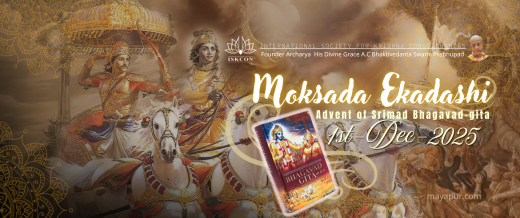
As we approach the sacred occasion of Gītā Jayanti on Mokṣadā Ekādaśī, our hearts naturally turn toward the divine moment when Lord Krishna personally spoke the Bhagavad-gītā to Arjuna. Srila Prabhupada reminds us:
“Because Bhagavad Gita is spoken by the Supreme Personality of Godhead, one need not read any other Vedic literature. One need only attentively and regularly hear and read Bhagavad Gita.”
For over 30 years—since 1994—the Bhaktivedanta Gita Academy (Mayapur) has been enriching countless lives through the teachings of the Bhagavad-gītā As It Is. Their courses, including the Gita Study Course and others, are carefully designed to benefit everyone—whether a newcomer or a seasoned practitioner. These systematic studies help devotees deepen, mature, and strengthen their Krishna consciousness in a heartfelt way.
We know the Bhagavad-gītā is widely known, yet often misinterpreted. Srila Prabhupada emphasized that his purports are not his own speculation but express the essence given by our previous ācāryas. Around 1970 in Indore, at a grand Gita Jayanti gathering with many speakers, Srila Prabhupada’s clear and authoritative presentation exposed the flaws of the mental speculators present there.
He powerfully instructed us:
“Anyway, print books, distribute profusely, and that will be the best preaching work. What will your three minutes’ preaching do? But if they buy one book, it may turn their life… Make this your important task, to print our books… and distribute widely… our process is slow but sure.”
Here in Sri Mayapur, Gita Jayanti is celebrated joyfully for three days—pandals, bookstands across the campus, harinam, and (especially) book distribution. On the main day, a fire yajña is performed while devotees chant all 700 verses of the Bhagavad-gītā. Visitors, residents, and pilgrims spend the day immersed in transcendental bliss.
This year, if you are not able to personally go out for book distribution, you can still fully participate by sponsoring Bhagavad-gītās for distribution in places where Krishna’s teachings have still not reached strongly. Your sponsorship ensures the Gita goes to villages, schools, remote locations, and receptive hearts waiting for Krishna’s words.
Even one Gita can change a life.
If you feel inspired, you can contribute here:
https://www.mayapur.com/festivals/Gita-Jayanti
Thank you for your kind-hearted support. May Sri Krishna bless you on this sacred Mokṣadā Ekādaśī with wisdom, devotion, and the joy of sharing His message.

Hare Krishna dear devotees,
Please accept my humble obeisances. All glories to Srila Prabhupada.
We warmly invite you to join us in Rajapur on November 26th for the auspicious Odana Ṣaṣṭī Festival of Sri Sri Jagannath, Baladeva and Subhadra Devi. On this sacred day, the Lords receive Their first winter garment, a beautiful tradition lovingly described in Sri Caitanya-caritāmṛta. Remembering how Pundarika Vidyanidhi received special mercy on this day, we pray that this festival brings deep blessings to all our hearts.
Festival Schedule:
8:00 – Bhagavatam Class by HH Subhag Swami Maharaj
9:00 – Darshan Arati
9:30 – Drama, Śloka Offerings & Dances
11:00 – Bhajans
11:45 – Offering of Bhoga brought by devotees
12:00 – Kirtan till 1 PM
If you feel inspired to serve Their Lordships personally, you may sponsor any of the festival sevas. You can explore the options here:
https://www.mayapur.com/festivals/Odana-Sasti
Your heartfelt contribution helps keep this beautiful service to Lord Jagannath alive.
Hope to see you in Rajapur!
Your servant,
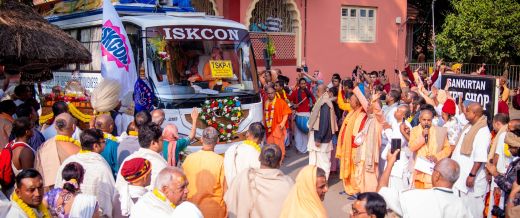
Vijaya Yātrā Praṣṭhān 2025!
Yesterday was a very special day here in Śrīdhāma Māyāpur. The temple was filled with colourful rangolis, joy, emotion, and a deep sense of purpose as we gathered for the Vijaya Yātrā Praṣṭhān — the official send-off for this year’s Sankīrtan party. Instead of the usual Śrīmad Bhagavatam class, the community came together to offer prayers, blessings, and encouragement to the devotees preparing to go out and distribute Śrīla Prabhupāda’s books during the annual book marathon.
The program began with a yajña, where everyone joined in prayers for protection and success. After that, we all took darśana and joined in āratī, filling the temple with kīrtan and heartfelt devotion. Senior devotees then spoke words of wisdom and inspiration, reminding us that book distribution is not just an activity — it is an act of compassion, a way of sharing Krishna with the world.
Here in Māyāpur, distributing Śrīla Prabhupāda’s books is at the very heart of our mission. Some devotees will travel across India, meeting people from all walks of life, while others will continue distributing books right here within the campus — but the mood remains the same: to give everyone an opportunity to come closer to Krishna.
Śrīla Prabhupāda often emphasized that if someone simply sees or holds one of his books, they receive benefit — and if they read it, their life can transform. So every book given is like planting a seed of bhakti in someone’s heart.
As the Sankīrtan team begins their journey, we send them forward with our prayers and gratitude. May Lord Caitanya, Lord Nityānanda, and Śrīla Prabhupāda guide them, protect them, and allow them to touch many hearts.
We look forward to welcoming them home again around Gaura Pūrṇimā, filled with realizations, mercy, and stories of how Krishna worked through them.
All glories to Śrīla Prabhupāda.
All glories to the Sankīrtan devotees.
